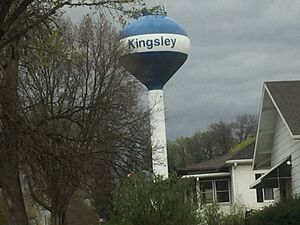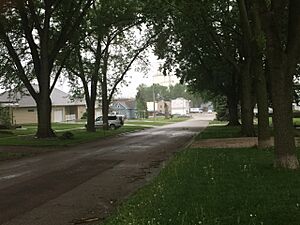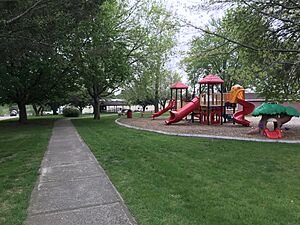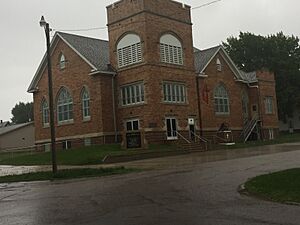Kingsley, Iowa facts for kids
Quick facts for kids
Kingsley, Iowa
|
|
|---|---|
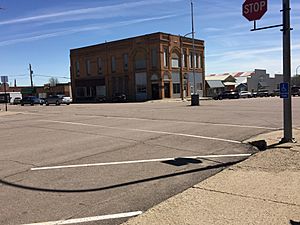
Downtown Kingsley
|
|
| Motto(s):
Some Bigger. None Better.
|
|

Location of Kingsley, Iowa
|
|
| Country | |
| State | |
| County | Plymouth |
| Government | |
| • Type | Mayor–council |
| Area | |
| • Total | 1.61 sq mi (4.18 km2) |
| • Land | 1.61 sq mi (4.18 km2) |
| • Water | 0.00 sq mi (0.00 km2) |
| Elevation | 1,257 ft (383 m) |
| Population
(2020)
|
|
| • Total | 1,396 |
| • Density | 864.93/sq mi (333.97/km2) |
| Time zone | UTC-6 (Central (CST)) |
| • Summer (DST) | UTC-5 (CDT) |
| ZIP code |
51028
|
| Area code(s) | 712 |
| FIPS code | 19-41385 |
| GNIS feature ID | 0458095 |
Kingsley is a small city in Plymouth County, Iowa, United States. It is located within Garfield Township. In 2020, about 1,396 people lived there.
Kingsley was not always in its current spot. It started as a village called Quorn. Two brothers, Frederick and William B. Close, founded Quorn. They named it after the Quorn Hunt in England.
The village had to move because a railroad did not go through its original location. The Chicago and North Western Transportation Company built the railroad. The new town was named Kingsley. It was officially founded on January 15, 1884. Kingsley celebrated its 100th birthday in June 1984.
Today, Kingsley has many groups and fun activities. It has a local government with a mayor and a city council. Students attend Kingsley Elementary School and Kingsley–Pierson High School. Middle school students go to school in Pierson.
The city offers a golf course and a public swimming pool for recreation. There is also a public library. Kingsley once had its own newspaper, The Kingsley News-Times. Now, it is part of The Record, which covers several nearby cities. Many businesses and homes are found within Kingsley. Famous people like former U.S. President Herbert Hoover and baseball player Harry Gaspar have connections to Kingsley.
Contents
Kingsley's Interesting History
From Quorn to Kingsley: A Town on the Move
The city we know as Kingsley began as a village called Quorn. It was named after a famous hunt in England. Brothers Frederick and William B. Close started Quorn on September 18, 1880. They began with a large 2,000-acre farm. This farm had buildings, sheds, and many animals. These animals included sheep, cattle, and hogs.
The Close brothers invested more money into Quorn. Soon, it had a post office, a country store, and a social center. Quorn grew to have 300 to 400 people. Many buildings lined its Main Street.
A new railroad was being built. Everyone in Quorn hoped it would pass through their village. This would connect them to Sioux City, Iowa. But the railroad took a different path. No one knows the exact reason why. Some thought it was due to a disagreement with the Chicago and North Western Transportation Company.
Since the railroad was key for moving goods, people had to leave Quorn. Almost every business moved to a new area in 1883. Only one mill stayed behind.
Building the New Kingsley
Kingsley was founded on January 15, 1884. It was named after Nahum P. Kingsley. He had planned out the new city on June 4, 1883. In June 1984, Kingsley celebrated its 100th birthday. Former U.S. President Ronald Reagan sent a message. He praised the community's strong spirit.
Kingsley has always worked to improve itself. In June 1894, a large 1,500-gallon water tower was built. It helped pump water for the town. This tower collapsed in October 1905. A new steel tower was built in January 1906. Another new water tower replaced the 1906 one in 1915. A sewer system was added in 1912. It was made even bigger in 1968.
Many new additions have come to Kingsley. In June 1990, the Loring Aquatic Center opened. This is a public swimming pool. In 1996, an old grain elevator burned down. Firefighters used it for practice. New playground equipment was added to Kingsley's park in June 2000. High-speed internet came to the city in May 2002.
A new water tower was finished in May 2004. From 2005 to 2006, a walking trail was completed. A new water main was built in June 2008. In 2009, Kingsley had about 80 businesses. Nearly 70 new houses were built between 2001 and 2009.
Community Groups and Local News
After Quorn was founded, a secret group called The Spooks began. Every Christmas, they gave free food and clothes to people in need. They helped people in Quorn and later in Kingsley. Only the members know who is part of The Spooks. They wear masks and still operate today.
The Women's Kingsley Community Action Club started in June 1980. This group helps with summer programs for Kingsley's young people.
Kingsley used to publish its own newspaper, The Kingsley-News Times. It started in 1887. J. H. Strief founded the newspaper. He later became president of the Iowa State Federation of Labor. The Kingsley-News Times later joined two other newspapers. They formed The Record. This new paper covers news for several nearby cities.
Where is Kingsley Located?
Kingsley is located at 42°35′21″N 95°58′6″W / 42.58917°N 95.96833°W. It is in Garfield Township, within Plymouth County. Kingsley is part of the Sioux City metropolitan area. This area includes parts of Iowa, Nebraska, and South Dakota.
The city is located within the Loess Hills. These are unique hills made of wind-blown soil. Kingsley is in an area known for growing grain and raising livestock. The city is 1,230 feet (375 meters) above sea level. Farmland surrounds Kingsley. Many of the first farms were owned by the Close brothers.
Kingsley's Population Over Time
| Historical populations | ||
|---|---|---|
| Year | Pop. | ±% |
| 1890 | 649 | — |
| 1900 | 720 | +10.9% |
| 1910 | 977 | +35.7% |
| 1920 | 1,072 | +9.7% |
| 1930 | 1,093 | +2.0% |
| 1940 | 1,145 | +4.8% |
| 1950 | 1,098 | −4.1% |
| 1960 | 1,044 | −4.9% |
| 1970 | 1,097 | +5.1% |
| 1980 | 1,209 | +10.2% |
| 1990 | 1,129 | −6.6% |
| 2000 | 1,245 | +10.3% |
| 2010 | 1,411 | +13.3% |
| 2020 | 1,396 | −1.1% |
| Source: and Iowa Data Center Source: |
||
Kingsley's Population in 2020
In 2020, the census counted 1,396 people living in Kingsley. There were 585 households and 375 families. The city had about 865 people per square mile. Most residents (95.8%) were White. About 2.2% of the population was Hispanic or Latino.
The average age in Kingsley was 43.1 years. About 26.5% of residents were under 20 years old. And 23.0% were 65 years or older. The population was 47.8% male and 52.2% female.
Education in Kingsley
Kingsley has two schools: Kingsley Elementary School and Kingsley–Pierson High School. Both schools are at the same address. Students in middle school attend classes in Pierson, Iowa. All three schools are part of the Kingsley–Pierson Community School District.
The elementary school serves about 163 students. The high school has about 139 students. The high school has a great student-to-teacher ratio of 10:1. This is much lower than the national average of 16:1. High school sports teams include basketball for boys and girls, and Track & Field. In 2017, the school district was ranked 74 out of 215 for Best High School for Athletes in Iowa.
Fun Things to Do in Kingsley
Kingsley offers many ways to have fun and stay active.
- The Loring Aquatic & Fitness Center is a public swimming pool.
- Brookside Golf Course is a great place to play golf.
- There is a local park with new playground equipment.
- A walking trail is available for exercise.
- The city also has a community center.
- Kingsley is home to five churches of different faiths.
Getting Around Kingsley
Iowa Highway 140 passes right by Kingsley. It goes past the Brookside Golf Course and ends at the start of Main Street. The highway runs about 1 kilometer next to Kingsley. The Siouxland Community Transit System provides bus services. It serves all of Plymouth County and other nearby counties.
Famous People from Kingsley
- President Herbert Hoover lived in Kingsley as a child with his grandmother.
- Cincinnati Reds baseball player Harry Gaspar was born in Kingsley.
- Washington Huskies football offensive coordinator Ryan Grubb was born in Kingsley.
See also
 In Spanish: Kingsley (Iowa) para niños
In Spanish: Kingsley (Iowa) para niños


